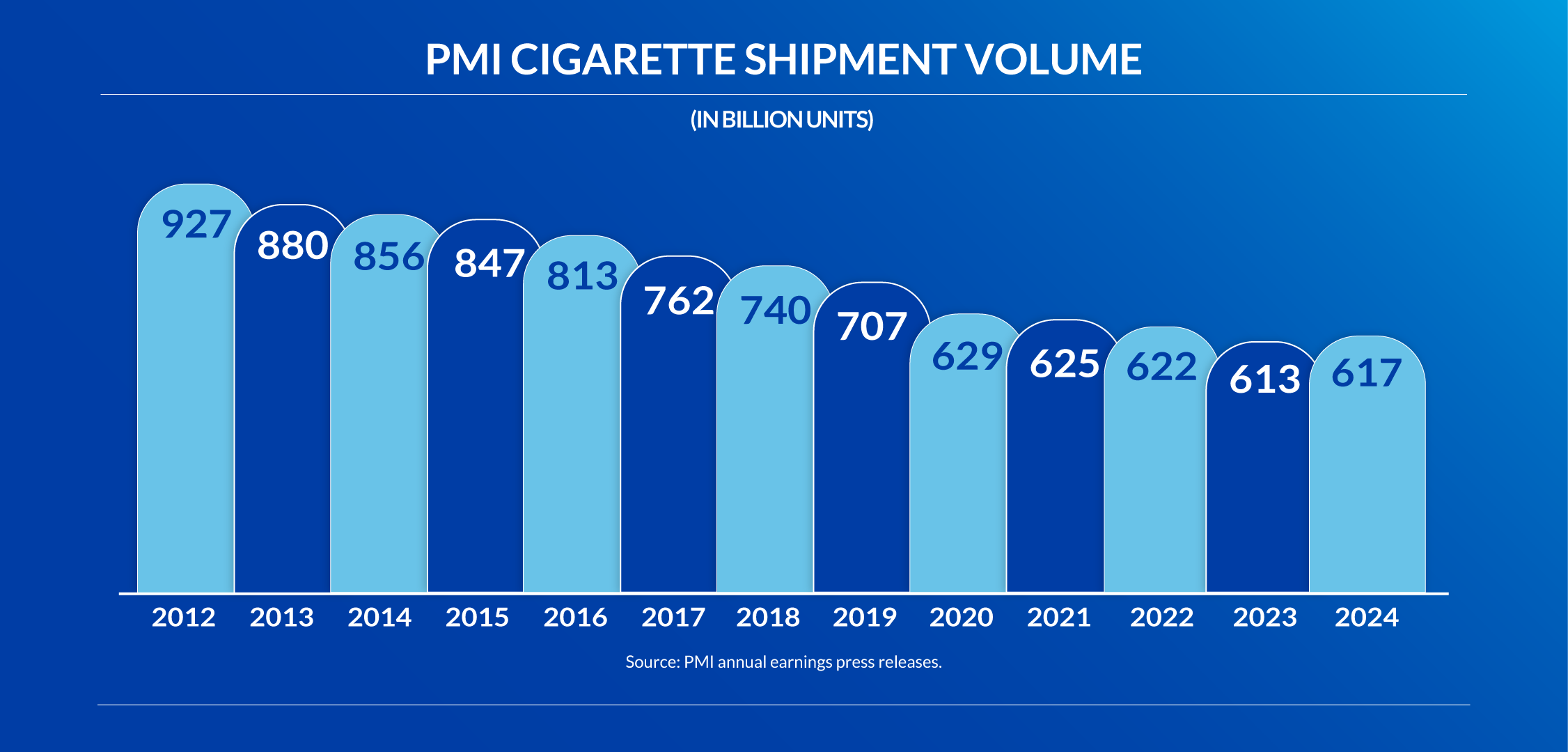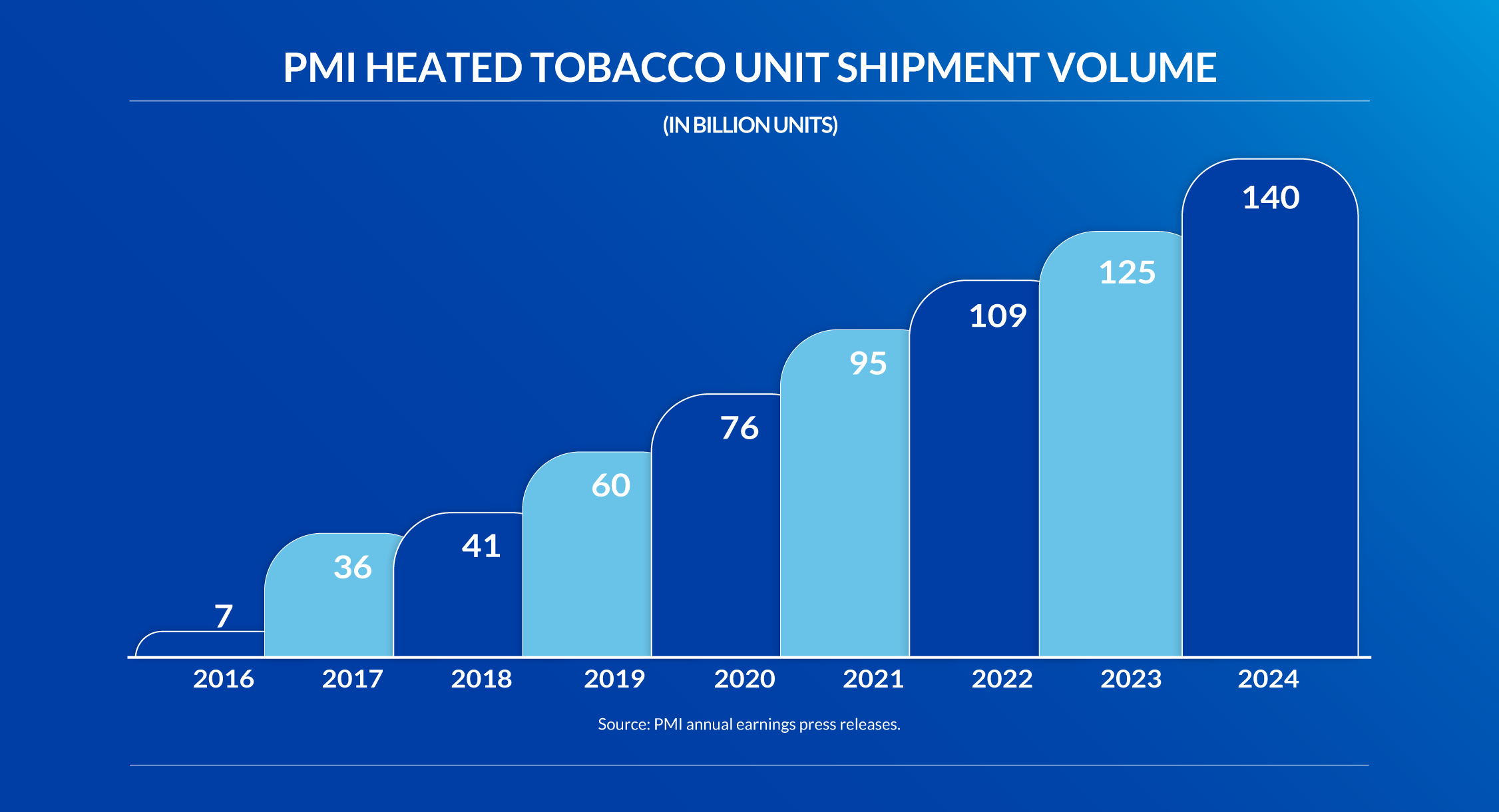At Philip Morris International (PMI) we have publicly declared our ambition to stop selling cigarettes. Instead, we are building our future on less harmful, yet satisfying alternatives to smoking, and have already invested over USD 14 billion to bring these innovations to market.
The result? As of Q3 2025, smoke-free products accounted for 41 percent of our total global net revenues, and we aim to reach over two-thirds by 2030. That’s up from zero just over a decade ago when we first launched our heated tobacco product.
More importantly for public health, over 23 million adult smokers have abandoned cigarettes completely and switched to this product, which the U.S. Food and Drug Administration (FDA) authorized in 2020 as a modified risk tobacco product (MRTP) with reduced exposure claims, adding that its modification order was “appropriate to promote the public health, and is expected to benefit the health of the population as a whole.”
*Smoke-free business net revenues as of Q3 2014. ** Smoke-free business net revenues as of Q3 2025. Important note: This information should be read in conjunction with the Philip Morris International Inc. earnings release dated October 21, 2025, as well as the accompanying glossary of key terms, definitions, explanatory notes, select financial information and reconciliations of non-GAAP financial measures, both of which are available on our Investor Relations pages. “PMI,” “We,” “Our,” & “Us” refers to the entire Philip Morris International family of companies.
In addition to this, in 2019, Swedish Match’s General snus brand was the first tobacco product to be granted an MRTP for sale in the U.S. with reduced risk claims, and this is the same product category which has contributed to Sweden now having the lowest smoking rate—and the lowest lung and oral cancer rate—in Europe. And ZYN became the first FDA–authorized nicotine pouch in January 2025. Swedish Match’s application for an MRTP authorization to communicate risk messaging for ZYN is currently pending with the FDA.
So, now that we are offering a portfolio of better alternatives to smoking, and millions of adult smokers are switching completely to these products, why are we still selling cigarettes?
Change: Giving adult smokers access to, and information about, better alternatives to cigarettes
The answer lies in something often overlooked: The real-world mechanics of change. The truth is that it’s not enough for us to design, test, scientifically substantiate, and offer better alternatives to adult smokers because, alone, this will not end smoking.
Human behavior and freedom of choice are considerations. Everyone knows smoking is harmful, and yet hundreds of millions of people choose to continue smoking.
Some governments allow adult smokers access to, and information about, better alternatives. Others deny them this choice, and there remain far too many countries with very high smoking prevalences where only cigarettes—the most harmful way to consume nicotine—can be legally sold. This needs to change.
As our CEO, Jacek Olczak, said: “Some countries that have prohibited smoke-free products are seeing higher smoking rates persist, while many of those whose policies encourage smokers to make better choices are advancing away from cigarettes more quickly.”
Notwithstanding these barriers to progress, our cigarette shipment volumes have declined significantly over the past decade, while the volume of our smoke-free products has risen, demonstrating our commitment to change.


The impact of allowing smoke-free products into markets is clear. Indeed, in markets where our smoke-free products were for sale as of the end of 2024, our combustible product shipment volume decreased by more than 35 percent versus 2015.
And in Japan, smoking rates declined five times faster after smoke-free products were first introduced in 2014 according to independent research, while overall sales of tobacco products continued to fall.
The best choice for adult smokers is to quit smoking or, if they don’t, to switch to a better alternative. But, every year, nine out of 10 adult smokers continue to smoke. That’s why we need an approach that balances urgency with pragmatism.
In markets where our smoke-free products were for sale as of the end of 2024, our combustible product shipment volume decreased by more than 35 percent versus 2015.
Imagine if PMI, which is leading the industry in tobacco harm reduction, exited the cigarette market tomorrow. Would all our customers suddenly stop smoking? No. They would likely switch to other cigarette brands, many of them made by companies who—unlike us—have no intention of leaving cigarettes behind. Worse still, many would turn to illicit cigarettes, which are unregulated, untaxed, and potentially even more harmful.
This would put smokers at greater risk, while governments would lose tax revenue and public health would take a bigger hit.
Engage: Cigarette packaging can make adult smokers aware of better alternatives
Furthermore, if we suddenly stopped selling cigarettes, we’d lose access to adult smokers. They need to know better alternatives to the cigarettes they’ve just bought exist. They need to understand the science behind smoke-free alternatives and feel empowered to switch to them if they don’t quit—which is always the best choice.
That’s why, in markets where it’s permitted and where we sell smoke-free products, we use one of the few reliable communication channels still available to us which enables us to directly reach legal age smokers: Cigarette packaging.
In 60 countries (as of December 31, 2024), we use a QR code insert that directs adult smokers to online platforms where they can learn about our smoke-free portfolio. And this approach is working. Over 40 percent of those who engage with these platforms say they’re interested in hearing more or trying a smoke-free product.
In 2024, we expanded these efforts to reflect our multicategory approach, offering adult smokers information not only about our heated tobacco products, but also our range of nicotine pouches and e-vapor products. These digital touchpoints are a critical way to target adults who continue to smoke and encourage them to consider better choices if they don’t quit.
Impact: By putting adult smokers first, a smoke-free future can be achieved
Of course, this is not a strategy without tension. We understand that continuing to sell cigarettes while committing to stop selling them can appear contradictory. But abandoning our vision of a world that has left cigarettes behind prematurely would only delay the seismic societal impact we have committed to.
Our aim is not to sustain the cigarette business. Our aim is to move away from it, responsibly. The more countries that enable smoke-free products to be legally sold, and the faster we can encourage adult smokers that don’t quit toward better alternatives to cigarettes, the sooner we can stop selling cigarettes for good.




.png)